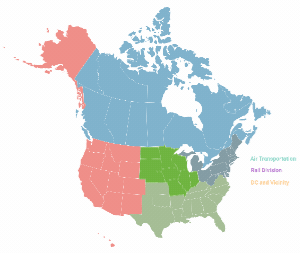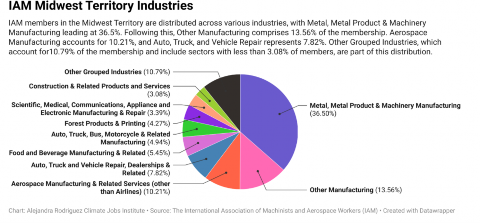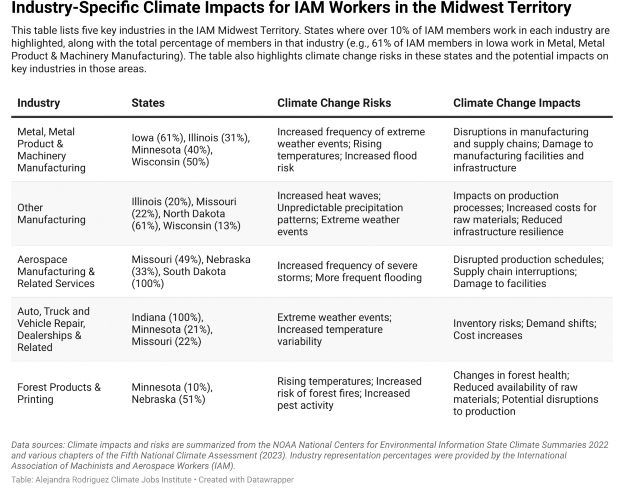The IAM Midwest Territory
 In the Midwest, with over 40,000 IAM members, Wisconsin and Illinois make up over half of the territory’s total membership, with 11,442 and 10,614 members respectively. This high number highlights these two states’ central roles in the region’s industrial activities. Missouri and Iowa are also key players, with strong industrial bases and more than 5,000 members each.92
In the Midwest, with over 40,000 IAM members, Wisconsin and Illinois make up over half of the territory’s total membership, with 11,442 and 10,614 members respectively. This high number highlights these two states’ central roles in the region’s industrial activities. Missouri and Iowa are also key players, with strong industrial bases and more than 5,000 members each.92
![]()
92 International Association of Machinists and Aerospace Workers, “Midwest Territory Revised,” June 28, 2024.

The dominant industry in the Midwest Territory is Metal, Metal Product & Machinery Manufacturing (35.50%). Other significant sectors include aerospace manufacturing (10.21%) and auto-related sectors (7.82%).93 Each state in the territory has its own unique mix of industries and members.94
![]()
93 International Association of Machinists and Aerospace Workers.
94 International Association of Machinists and Aerospace Workers.
IAM Midwest Territory Industries

Climate Change Impacts on the IAM Midwest Territory
The IAM Midwest Territory spans nine states facing significant climate impacts. These include rising temperatures, frequent heat waves, variable precipitation, heightened flood risks, threats to agriculture, ecosystem disruptions, health risks, and stress on aging infrastructure.95
Illinois experiences heavy precipitation that strains stormwater infrastructure and transportation systems.96 In recent decades, annual precipitation increased significantly,97 and the state now encounters more frequent wet and dry extremes, earlier snowmelt, and intense spring precipitation, all of which elevate the risks of floods, droughts, soil erosion, and nutrient runoff.98 In fact, every state in the region has seen temperature increases that heighten the risk of extreme weather.99
Industry-Specific Climate Impacts and Implications for IAM Workers in the Midwest Territory
The Midwest Territory encompasses a diverse range of industries, each uniquely impacted by climate change. These impacts pose significant challenges for workers, affecting their health, safety, and job security. The “Industry-Specific Climate Impacts for IAM Workers in the Midwest Territory” chart offers a summary of how five key industries and various states in the IAM Midwest Territory are affected.100
![]()
95 Knapp et al., “Chapter 25: Northern Great Plains,” 25; Wilson et al., “Chapter 24: Midwest.”
96 Wilson et al., “Chapter 24: Midwest.”
97 Baule, Andresen, and Winkler, “Trends in Quality Controlled Precipitation Indicators in the United States Midwest and Great Lakes Region”; Hayhoe et al., “Chapter 2: Our Changing Climate. Impacts, Risks, and Adaptation in the United States.”
98 Chen and Ford, “Future Changes in the Transitions of Monthly to Seasonal Precipitation Extremes over the Midwest in Coupled Model Intercomparison Project Phase 6 Models”; Byun, Chiu, and Hamlet, “Effects of 21st Century Climate Change on Seasonal Flow Regimes and Hydrologic Extremes over the Midwest and Great Lakes Region of the US.”
99 Kunkel et al., “State Climate Summaries for the United States 2022.”
100 International Association of Machinists and Aerospace Workers, “Midwest Territory Revised,” June 28, 2024; Kunkel et al., “State Climate Summaries for the United States 2022”; Wilson et al., “Chapter 24: Midwest.”
Industry-Specific Climate Impacts for IAM Workers in the Midwest Territory

